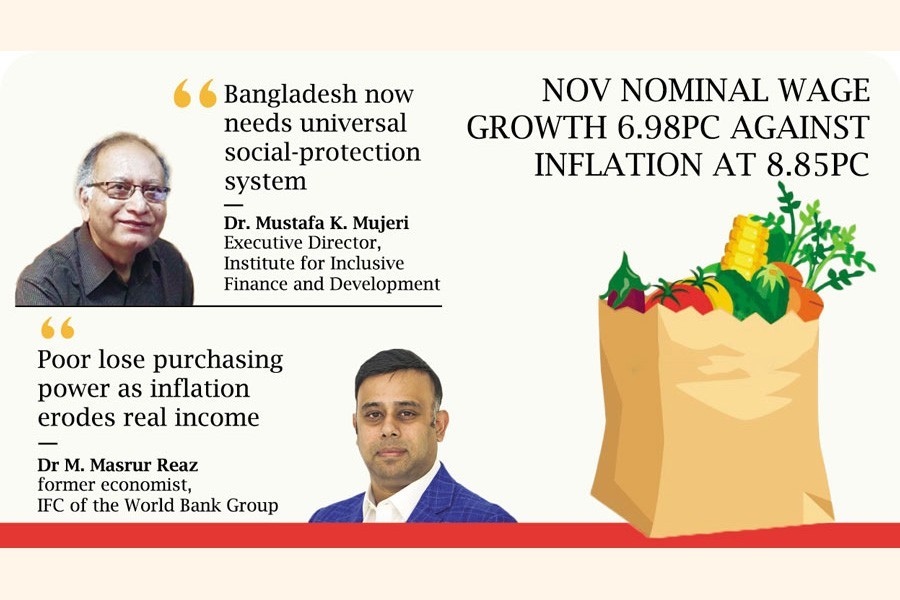Commoners pay through their nose as wage growth in Bangladesh remains stubbornly far lower than consumer prices fueled by soaring headline inflation, economists say as official data show the gap.
As a result of the gaping pay-and-price gap, economists say, limited-income people who are mostly breadwinners of their families are losing purchasing power.
Reverting poverty rate, education dropout and malnutrition are among the feared fallouts from the hardship.
Bangladesh Bureau of Statistics (BBS) in its latest publication shows that the wage rate fell well short of consumer-price inflation for November 2022.
The rate of nominal wage growth in November was 6.98 per cent on a point-to-point basis although the rate of inflation stood at 8.85 per cent--a gap of nearly 1.87-percentage points.
Agriculture sector's nominal wage growth was recorded at 6.95 per cent, fishing at 4.46 per cent, industry at 7.06 per cent construction 5.52 per cent, and service 7.17 per cent.
Only workers in production sector beat the inflation rate as it recorded a hike of 9.61 per cent against November inflation in of 8.85 per cent.
The BBS designed Wage Rate Index (WRI) as an important gauge for the trend and changes in the aggregate wages of the wage-earners. The wage index is intended to measure movement of nominal wages of low-paid skilled and unskilled labourers over time in different sectors of the economy. It is also used to measure changes in real wages.
Economists familiar with the developments told the FE that the wage growth and the inflation rate had no gap in the past, and in some cases, wage growth used to be higher than the rate of inflation. But the gap now widens, rendering it hard to make two ends meet.
However, they feel that wage-hike pressure on the entrepreneurs is not justified because they have been facing power and gas shortages alongside export fall.
"The poor have lost their purchasing power as the inflation erodes the real income," says Dr M. Masrur Reaz, a former economist at the IFC of the World Bank Group.
The poverty rate may widen as a result of the gap. And malnutrition as a result of poor diet may increase in the country, he told the FE.
He notes that the government may provide support to the poor to offset the inflation spikes.
The government may provide subsidy in utility bills including power bills, says, adding that the OMS and public-transportation facility may widen for the poor.
Dr Mustafa Kamal Mujeri, executive director at the Institute for Inclusive Finance and Development (InM), says if the rate of inflation exceeds the rate of nominal wage growth, then their real income gets eroded. Such situation leads to lowering the standard of living of the people, especially the limited-income group of people.
"The poor people avoid the expense for healthcare services as a result of shrinking real wages," he tells the FE in explaining the paradox.
It also might lead to dropping out from education (for lower-income group of people).
Dr Mujeri mentions that there are some social protection programmes that exist in the country but the monthly or yearly allocation is very much poor to cope with the rising prices of essentials.
He feels that Bangladesh now needs a universal social-protection system that is based on fair targeting to combat such shocks, from global and domestic crunch.
The BBS measures the wages as the amount of money received either in cash or in kind in a day for standard daily working hours or earnings of low-paid labourer who works on an hourly basis.
The wage index is intended to measure movement of wages of low-paid skilled and unskilled labourers over time in main sectors of the economy, such as agriculture, industry, and services.
Wage Rate Index or WRI has been rebased from 1969-70=100 to 2010-11=100 under these main three sectors of the economy in respect of 44 occupations comprising 11 occupations from agriculture, 22 from industry, and 11 occupations from services sector.


